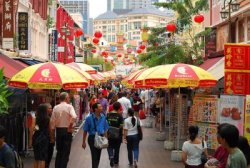Manila Philippines - Chinatown: An Intriguing Adventure Awaits You
An intriguing and lively destination, Chinatown in Manila Philippines, proposes a shopping and destination ambiance that is uniquely Filipino-Chinese.
As early as the 10th century, lively trade has been going on between itinerant merchants coasting along the China Sea and the riverbank dwellers of the Pasig River in Manila Philippines.

Chinatown Manila, Philippines |
At the northern bank of the river sprang a thicket-and-woods village where a community of Chinese lived peacefully among the Tagalogs when the Spaniards came.
The village was called Binundok, a Tagalog term for hilly terrain, but the Spaniards perpetuating a corruption of its name, referred to it as Isla de Binondo (Isle of Binondo).
During the trading galleon centuries, the mercantile town of Binondo served as the center of the trading post between Asia and the New World, trade that was to sustain a colony for 300 years and spawn enormous fortunes.
Today, with its maze of narrow streets, store-houses, bazaars, restaurants and business establishments, Binondo seems hardly changed after centuries as the Chinese borough of Manila Philippines.
Still bustling with endless commercial activity, this former core of international trade has now become a haven for those in search of authentic oriental cuisine and bargains.
Ongpin, the major artery that cuts through Chinatown’s heartland is an enticing treasure trove of gold-smithery, countless eateries serving Chinese dishes, pastry shops with tempting oriental delicacies and apothecaries selling herbal packets and exotic remedies.
Equally inviting are the intertwining side streets and alleyways along the thoroughfare boasting of an overwhelming array of assorted goods ranging from fresh produce and preserves to oriental ornaments, hardware and furniture shops.
But there is more to Chinatown than mere shopping. There are many good places to see. One of these is the Carriedo Fountain. Nestled at the heart of Plaza Sta. Cruz and Bustos street, this was built to honor “Manila Philippines greatest benefactor” -- Francisco Carriedo y Peredo, who donated a generous amount for the establishment of the first waterworks system to serve the entire city of Manila Philippines.
In recognition of the outstanding efforts and immense commitment of Mayor Arsenio H. Lacson, Manila’s first elected chief executive, the city mounted the Lacson monument in his honor. Dubbed as “Manila’s fightingest mayor,” his administration struggled for a clean, honest and efficient city government.
The Arch of Goodwill ushers in visitors from the Sta. Cruz rim. Standing over Ongpin street, the Arch commemorates the centuries-old relationship between two cultures, Chinese and Filipino in Manila Philippines.
With interiors ornately outlined in red and gold, the Philippine-Chinese Buddhist Temple is one of the most frequented in the community. A shrine to Kuan Yin, goddess of mercy and Kuan Te Yo, god of businessman, it is visited daily by countless worshippers to light joss sticks, offer food, or simply to seek guidance from these deities.
Uniquely and interestingly located along Ongpin and Tomas Pinpin streets, this unusually tiny side street chapel is a solid example of syncretism inherent in the Sino-commercial district. This is always dappled with flowers and burning sandalwood incense.
Primarily intended for Parian Chinese converted to Christianity during the colonial period, Sta. Cruz church was constructed in the early 17th century and was considered as one of the oldest churches built outside Intramuros. Heavy bombings of Manila Philippines during WW II, however, totally destroyed the original church and from its ruins rose the present church.
Once a fine example of Spanish colonial architecture, the original Binondo church was built during the latter part of the 16th century to accommodate the Christian baptized Chinese.
Especially noted for its six-storey octagonal bell tower, the church, now a minor basilica, is the shrine of the first canonized Filipino-Chinese martyr and saint, San Lorenzo Ruiz, who, during his childhood, served as an altar boy. His larger-than-life statue looks out from across the basilica.
A statue standing close by the Binondo church is Filipino-Chinese philanthropist Ramon Ongpin, the first dealer of art supplies in Chinatown. He was the first to wear the barong tagalog, the Filipino national costume. The main street called Ongpin was named after him.
Kaisa Heritage Center houses Bahay Tsinoy, a museum showcasing an impressive heritage exhibit in dioramas tracing the history of the Philippine-Chinese pre-Hispanic times to the colonial period. Rare prints and photographs, porcelain collections are likewise part of the exhibit.
Adding color to the charms of all, are the activities of tenacious vendors in Tutuban Central mall, Divisoria and Arranque market. A medley of clothing boutiques, trinket outlets, clothing shops, shoes, bags, and a little mixture of everything that is Manila Philippines.
Haggling is always the name of the game whether you are a seasoned shopper or a mere bargain hunter.


